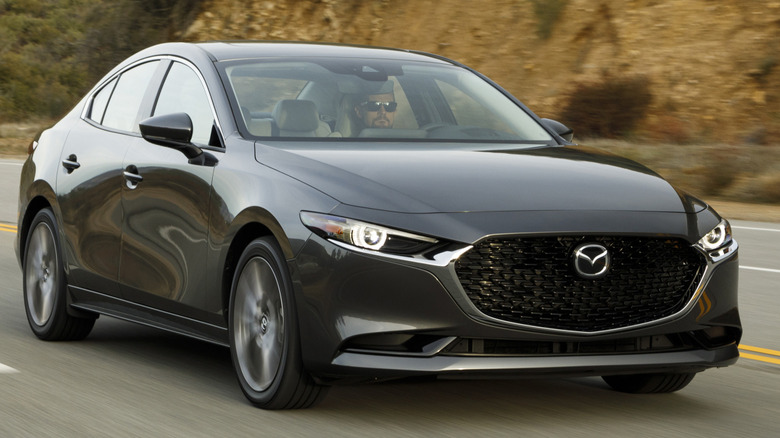Who Makes Mazda's Engines & Are They Any Good? (According To Owners)
Mazda has historically insisted on building its own engines in-house, starting at its Hiroshima plants in Japan and later expanding production to regional facilities in China, Mexico, and Thailand to meet global demand. That independence gave us the brand's signature SKYACTIV-G engines — naturally aspirated fours that still power nearly every Mazda model today — and kept oddballs like the iconic rotary engine alive when other brands went conventional.
But Mazda hasn't always done it alone. Before its expansion, Mazda shared development with Ford, which supplied certain powertrains, most notably in the first-gen CX-9 and the 2008-2009 Tribute Hybrid. More recently, Toyota has supplied full hybrid systems, including the CX-50 hybrid sold in the U.S. and China, the Europe-only Mazda2 Hybrid, and the Axela/Mazda3 Hybrid offered in Japan between 2013 and 2019. Mazda's own hybrids, including the CX-60, CX-70, CX-80, CX-90, and MX-30 R-EV plug-in hybrids, are built entirely by Mazda, paired with the in-house SKYACTIV engines and some form of the company's M Hybrid or e-Skyactiv electrification.
Owner data indicates that the naturally aspirated SKYACTIV engines are among the most reliable Mazda engines in the class, with numerous high-mileage stories reported without any major repairs. However, some older engines have caused problems serious enough to show that even Mazda's record has weak spots. Unlike rivals that can blame their corporate parent, Mazda has built most of its engines in-house — so when things go right or wrong, there's usually no one else to blame or to credit. As you'll see, some engines went wrong in ways Mazda owners won't soon forget.
The MZI 3.7-liter V6 in the first-gen CX-9 and Mazda6 left a trail of expensive failures
Between 2008 and 2015, the CX-9 was powered by Ford's 3.7-liter Duratec V6 (badged "MZI" by Mazda), also used in the Mazda6 V6 and several Ford/Lincoln products. Ford put the engine's water pump behind the timing cover, so when the pump's seal fails — which owners consistently report around 90,000-130,000 miles — coolant from the pump could leak into the engine oil. Once that happened, the coolant mixed with oil, and could destroy the engine if not caught early.
NHTSA and CarComplaints data show the same window of failure across multiple model years. For the 2008, 2010, 2013, and 2015 models — the ones with both cost and mileage entries — the average repair runs about $4,468 at around 105,000 miles. Mazda did release a TSB, but it was more of a labor time guide for dealers than a solution for drivers.
The worst part is that catching the problem was nearly impossible without tearing down the front of the engine, which alone demanded 10-plus hours of labor and thousands in cost. If you were lucky, you'd just be on the hook for a pump replacement. If you weren't, and the engine was already trashed, a full engine swap was the only option. Owners report quotes up to $10,000 for replacements on cars already a decade old. Mazda never issued a recall, but there was a lawsuit filed in 2019, which was dismissed in 2023, without Mazda being required to give owners any compensation.
Mazda's early 2.5-liter SKYACTIV engines cracked under pressure with oil and coolant leaks
The only good thing that came out of Mazda's MZI engine's design flaw was that it pushed the brand to double down on its upcoming SKYACTIV-G engine designs. But like any first-generation technology, the first few years exposed real weaknesses that Mazda had to engineer around. One of the most serious involved both the 2.5-liter with cylinder deactivation and the 2.5-liter turbo, first seen in the 2018 CX-5 and Mazda6, and later used in the Mazda3 and CX-30. Both engines developed cracks in the cylinder head along the exhaust side — causing oil leaks in non-turbo models, and coolant burn-off near the manifold in turbos.
Owners report smoke, smell of burning oil, and, in bad cases, oil leaks severe enough to trigger a low-oil warning. With oil and coolant dripping onto hot components, many worried that their Mazdas could actually catch fire — a risk made worse by failures showing up as early as 26,000 miles. A few owners at CarComplaints mention engines overheating to the point of blowing a head gasket.
Mazda's response came in 2020 with a series of service bulletins that made clear the only fix was replacing the cylinder head with a revised design. The TSB's coverage soon grew to include 2018-2023 CX-5s, 2018-2021 Mazda6s, 2019-2023 Mazda3s, and 2020-2023 CX-30s. For a while, dealers faced backorders because so many cylinder heads needed replacing. But by 2021, the updated design was in production, and complaints have since dropped sharply in later cars.


